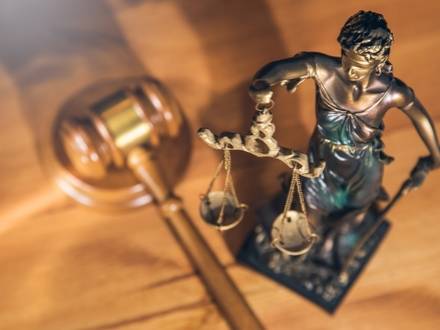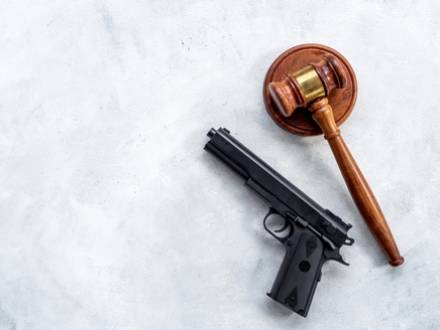Recent Blog Posts
DNA Collection May Lead to Increased Government Surveillance
 Since the beginning of President Donald Trump’s second term in office, his administration has focused on cracking down on illegal immigration. Immigration and Customs Enforcement (ICE) and other branches of the Department of Homeland Security (DHS) have been conducting operations in which thousands of people have been detained, including undocumented immigrants, people who are in the country legally, and even U.S. citizens. As part of these efforts, DHS has been collecting DNA samples and other biometric data, which has raised concerns about increased government surveillance and the ways this data could be used in criminal cases.
Since the beginning of President Donald Trump’s second term in office, his administration has focused on cracking down on illegal immigration. Immigration and Customs Enforcement (ICE) and other branches of the Department of Homeland Security (DHS) have been conducting operations in which thousands of people have been detained, including undocumented immigrants, people who are in the country legally, and even U.S. citizens. As part of these efforts, DHS has been collecting DNA samples and other biometric data, which has raised concerns about increased government surveillance and the ways this data could be used in criminal cases.
For those who may be charged with federal crimes, understanding the role that DNA evidence, biometric data, and other information collected by the government can play in these cases is not always easy. In these situations, a skilled attorney can help ensure that a person’s rights will be protected while also working to develop successful defense strategies.
New Criminal Justice Reform Laws May Enhance the First Step Act
 The First Step Act was signed into law by President Donald Trump in 2018, and it made a number of reforms to the federal criminal justice system. It was meant to help reduce recidivism and ensure that people who have been convicted of crimes can re-enter society successfully after serving their sentences. While these reforms have been helpful, there are many additional opportunities for positive change in the justice system. Legislators recently introduced potential new laws that are meant to enhance and expand the First Step Act.
The First Step Act was signed into law by President Donald Trump in 2018, and it made a number of reforms to the federal criminal justice system. It was meant to help reduce recidivism and ensure that people who have been convicted of crimes can re-enter society successfully after serving their sentences. While these reforms have been helpful, there are many additional opportunities for positive change in the justice system. Legislators recently introduced potential new laws that are meant to enhance and expand the First Step Act.
Even after reforms have been made, people who face federal criminal charges may still be subject to harsh penalties, including lengthy prison sentences, high fines, restitution, and ongoing difficulties related to a criminal record. Legal representation from an attorney who has experience representing clients in federal courts can be crucial in these cases. A skilled criminal defense lawyer can help defendants address federal charges, fight against convictions, and minimize the effects on their lives.
Presidential Executive Orders Address Marijuana and Fentanyl
 During his administration, President Donald Trump has issued a large number of executive orders that have affected many areas of the law, including criminal cases. Recently, he issued two orders that may have an impact on drug crime cases. These orders addressed two substances that play a role in many drug cases: marijuana and fentanyl.
During his administration, President Donald Trump has issued a large number of executive orders that have affected many areas of the law, including criminal cases. Recently, he issued two orders that may have an impact on drug crime cases. These orders addressed two substances that play a role in many drug cases: marijuana and fentanyl.
For people who may face federal charges related to controlled substances, understanding how laws and government policies have changed is not always easy. Defending against federal crimes will require strong representation from an attorney who has experience in federal courts.
Trump Orders Federal Agencies to Reclassify Marijuana
For years, the federal government in the United States has classified marijuana as a Schedule I controlled substance. Despite the fact that most states have legalized marijuana for medical or recreational use, the U.S. government treats it similarly to the most dangerous substances, like heroin or methamphetamine. People who face federal charges related to marijuana may be sentenced to serve long terms in prison while facing a number of other penalties.
Why Is Mass Incarceration a Problem in the United States?
 For decades, criminal justice advocates have raised concerns about the rates of incarceration in the United States. The U.S. imprisons more people than any other independent democracy in the world. As of 2025, around two million people are incarcerated in local jails and state and federal prisons throughout the country, with 580 people being incarcerated for every 100,000 residents. This has not only placed a burden on the criminal justice system, but it has also affected the lives of countless people and families.
For decades, criminal justice advocates have raised concerns about the rates of incarceration in the United States. The U.S. imprisons more people than any other independent democracy in the world. As of 2025, around two million people are incarcerated in local jails and state and federal prisons throughout the country, with 580 people being incarcerated for every 100,000 residents. This has not only placed a burden on the criminal justice system, but it has also affected the lives of countless people and families.
While some states have attempted to reduce prison populations and limit incarceration whenever possible, others are expanding their jails and imposing harsher penalties on people who are convicted of crimes. Because of the risks that can affect those who face criminal charges, legal representation by an experienced attorney is crucial in these situations. A skilled lawyer can help a person defend against a conviction and take steps to minimize a potential jail sentence or other long-term consequences.
How Marsy’s Law May Affect the Rights of Criminal Defendants
 In recent years, the rights of victims have become an increasingly important concern in the criminal justice system. Multiple states have passed laws that provide a Victims’ Bill of Rights, and these are commonly known as Marsy’s Law. However, while these laws are well-intentioned, they have had a negative impact on the due process rights of criminal defendants while increasing burdens on the justice system.
In recent years, the rights of victims have become an increasingly important concern in the criminal justice system. Multiple states have passed laws that provide a Victims’ Bill of Rights, and these are commonly known as Marsy’s Law. However, while these laws are well-intentioned, they have had a negative impact on the due process rights of criminal defendants while increasing burdens on the justice system.
As advocates for victims’ rights continue to influence criminal cases, it is more important than ever for people who are facing criminal charges to secure representation from an experienced attorney. A lawyer who has a comprehensive understanding of the applicable laws and the steps that can be taken to protect a defendant’s rights can provide invaluable legal help while working to ensure that criminal cases can be resolved successfully.
Issues With Marsy’s Law
While laws that protect the rights of crime victims may seem like a good idea, they have had unforeseen effects on many criminal cases. The provisions included in Marsy’s Law vary from state to state, but they generally provide victims with the right to be notified about criminal proceedings and the right to be heard in criminal prosecutions, sentencing, and parole hearings. They also provide victims with the right to privacy, sometimes preventing their identities from being disclosed to the public and limiting the release of personal information. Victims also have the right to restitution that is meant to address the harm they have suffered.
Connecticut Towing Laws Can Lead to Vehicles Being Sold
 For most people, the ability to drive is essential. Cars are needed to get to and from work while also taking care of other responsibilities, such as running errands, transporting children to and from school, or attending medical appointments. The loss of a vehicle can be devastating. Unfortunately, due to the laws in Connecticut that detail when vehicles can be towed and whether they may be sold afterward, people who are charged with traffic violations or other offenses could face serious difficulties.
For most people, the ability to drive is essential. Cars are needed to get to and from work while also taking care of other responsibilities, such as running errands, transporting children to and from school, or attending medical appointments. The loss of a vehicle can be devastating. Unfortunately, due to the laws in Connecticut that detail when vehicles can be towed and whether they may be sold afterward, people who are charged with traffic violations or other offenses could face serious difficulties.
Because of the risks that people may face if their cars are towed, immediate action will need to be taken to recover vehicles. An attorney with experience addressing traffic laws and property that has been seized can provide guidance on how to address these issues and recover a towed vehicle as quickly as possible.
Vehicle Towing Laws in Connecticut
There are a variety of reasons why vehicles may be towed. Many of these cases involve parking violations, including situations where people who live in apartment complexes or condominiums park in certain spaces without the proper permits. Cars may also be towed due to unpaid parking tickets or other traffic violations. In some cases, a car that has been reported stolen may be towed, even if the person driving it believes that they purchased the car legally.
State and Federal Lawmakers Push for Increased Use of Cash Bail
 Bail reform is an issue that has been addressed by many criminal justice advocates. People who are arrested and charged with crimes will often be required to pay a certain amount of money before they can be released. Advocates have highlighted how these requirements affect people who do not have the financial means to pay bail, forcing them to remain in the custody of law enforcement while awaiting trial. While some states have taken steps to reduce or eliminate the use of cash bail, certain lawmakers and government officials are working to reverse these trends.
Bail reform is an issue that has been addressed by many criminal justice advocates. People who are arrested and charged with crimes will often be required to pay a certain amount of money before they can be released. Advocates have highlighted how these requirements affect people who do not have the financial means to pay bail, forcing them to remain in the custody of law enforcement while awaiting trial. While some states have taken steps to reduce or eliminate the use of cash bail, certain lawmakers and government officials are working to reverse these trends.
Issues related to bail and pretrial release can be complicated. Without legal representation, people who are arrested may be required to pay high amounts of bail, or they may be unable to secure a release. An experienced attorney can provide the legal help needed to advocate for a reduction or elimination of bail requirements while also helping to defend against a criminal conviction.
How Can the "Psychopath Test" Affect Criminal Cases?
 There are a wide variety of factors that can affect criminal cases, including details about an alleged crime and testimony from expert witnesses. When defending against convictions, defendants may not only need to take steps to address the facts of a case, but they may also need to respond to attacks on their character or assessments of their mental health. One factor that may play a role in certain types of cases is the "psychopath test," which may be used to assess a person’s mental state, gauge their level of remorse, and determine whether they may be a danger to the community.
There are a wide variety of factors that can affect criminal cases, including details about an alleged crime and testimony from expert witnesses. When defending against convictions, defendants may not only need to take steps to address the facts of a case, but they may also need to respond to attacks on their character or assessments of their mental health. One factor that may play a role in certain types of cases is the "psychopath test," which may be used to assess a person’s mental state, gauge their level of remorse, and determine whether they may be a danger to the community.
Legal representation is crucial in criminal cases to ensure that a person’s rights will be protected and that they will be able to respond to claims that call their character or their mental health into question. A skilled attorney can advocate on behalf of a defendant and challenge assessments that are based on subjective or faulty methods.
Supreme Court to Rule on Gun Ownership by Drug Users
 The laws surrounding firearms in the United States have seen some adjustments in recent years due to rulings by the U.S. Supreme Court. While many criminal justice advocates and lawmakers have called for stricter laws due to a large number of mass shootings and other gun deaths, the Supreme Court has done the opposite, striking down gun laws that supposedly do not fit into the "history and tradition" of the United States. The court is poised to address another aspect of gun laws that may affect users of marijuana or other drugs.
The laws surrounding firearms in the United States have seen some adjustments in recent years due to rulings by the U.S. Supreme Court. While many criminal justice advocates and lawmakers have called for stricter laws due to a large number of mass shootings and other gun deaths, the Supreme Court has done the opposite, striking down gun laws that supposedly do not fit into the "history and tradition" of the United States. The court is poised to address another aspect of gun laws that may affect users of marijuana or other drugs.
Because the laws related to firearms and other weapons seem to change regularly, there are many situations where people may face weapons charges after being arrested. When defending against these charges, it is important to work with a criminal defense attorney who understands the applicable federal and state laws and who can help determine the best strategies for success.
Supreme Court to Address Whether Police Can Enter a Home Without a Warrant
 In recent years, criminal justice advocates have raised concerns about police violence, including in situations where officers conduct raids or otherwise enter people’s homes. These situations may escalate, leading to injuries or deaths when officers open fire on people that they believe are carrying weapons or may present a threat. While advocates have worked to put policies in place that will limit these types of incidents, the U.S. Supreme Court seems poised to provide officers with more leeway in these situations.
In recent years, criminal justice advocates have raised concerns about police violence, including in situations where officers conduct raids or otherwise enter people’s homes. These situations may escalate, leading to injuries or deaths when officers open fire on people that they believe are carrying weapons or may present a threat. While advocates have worked to put policies in place that will limit these types of incidents, the U.S. Supreme Court seems poised to provide officers with more leeway in these situations.
Police raids, search warrants, and other related issues can play a significant role in a criminal case. People who have been charged with crimes in these situations will need to understand what steps they can take to defend against convictions. They can do so with the help of a skilled criminal defense lawyer who can advise them of their rights and provide representation in court.






